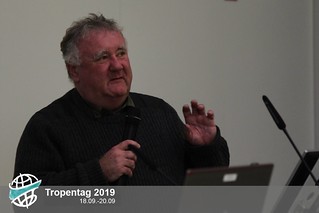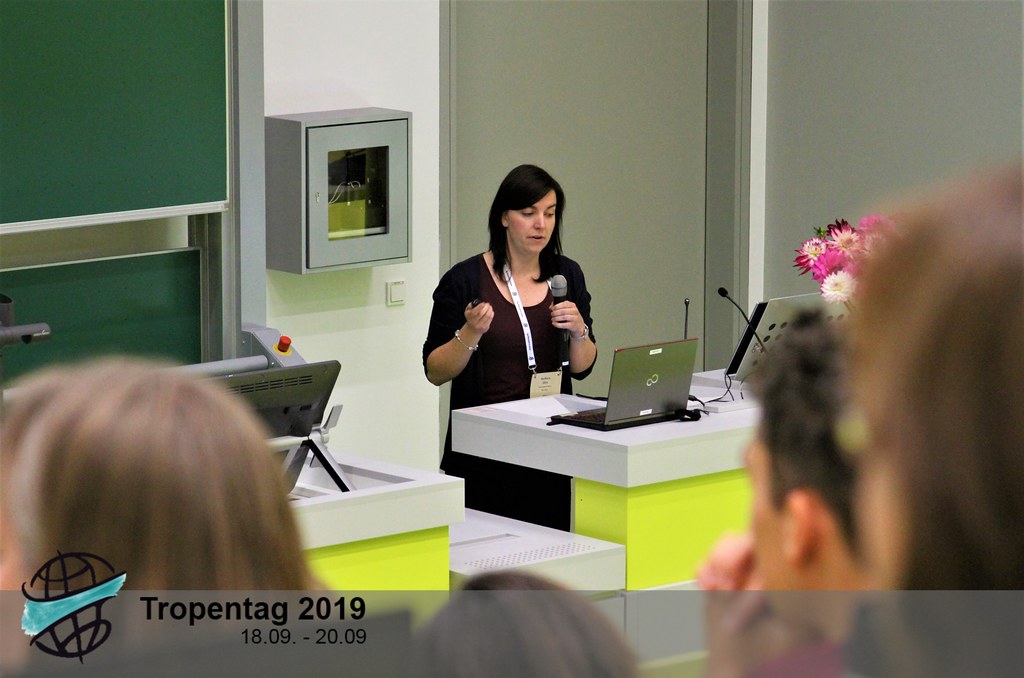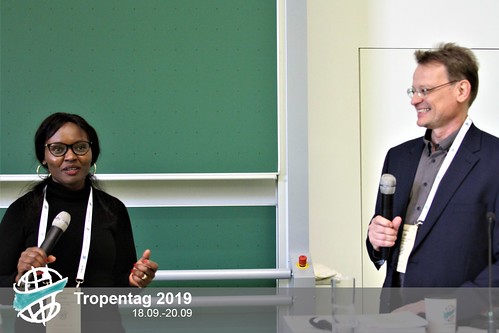Oral Presentations 2019
Hemp: grow it, not burn it!
Fri, 09/20/2019 - 18:23 — Oladokun
Danilo Crispim Massuela shares a compelling revelation about the potentials of Hemp as a socio-economic driver via his oral presentation at the #Tropentag2019.

The legality of hemp production continues to be a subject of global contention, as it varies widely across different countries. Danilo’s oral presentation takes us on a mental journey to the Quilombola Communities of the Brazilian São Francisco Valley, where hemp production should not be considered an option but a matter of necessity. This region is the highest producer of Cannabis in the country but rural poverty, hunger, social inequalities and food insecurity are the realities on the ground. This community are literarily so rich, yet so poor.

The legality of hemp production continues to be a subject of global contention, as it varies widely across different countries. Danilo’s oral presentation takes us on a mental journey to the Quilombola Communities of the Brazilian São Francisco Valley, where hemp production should not be considered an option but a matter of necessity. This region is the highest producer of Cannabis in the country but rural poverty, hunger, social inequalities and food insecurity are the realities on the ground. This community are literarily so rich, yet so poor.
Biological and economical battle of legumes and cereals..
Fri, 09/20/2019 - 16:23 — Ahmed
In the recent past decades, most funding programs and agricultural subsidies from both government and donors have been focused on cash crops such as cereals, to overcome food security rather than nutrition security. Less had been done to promote and empower legume farmers. The debate was raised during the ICARDA workshop session to get the opinions whether The intensification of cereals will make legumes economically unattractive to farmers!. “People don’t eat only cereals, they eat cereals products with legumes therefore, I think the demand will increase at the same pace”…”As cereals will be more in the markets, the price will be lower and the price of legumes will boom”… What do you think?!


Surprisingly, legumes are imported from Canada to Algeria! The similar trend had been observed in Morocco. Algeria's and Morocco’s main crops are cereals, mainly wheat and barley. Why not crop rotation? It's possible past crop failure due to diseases and pests and labour demand could be the traps for this trend in Algeria and Morocco. However, more evidence is needed.
Fearing Climate change? Farmers are the future…..
Fri, 09/20/2019 - 11:59 — Ahmed
“Under climate change environment it is real hard to forecast the future, farmers are the future”. The statement was given by Maik Veste from FarmImpact project in South Africa.
 CLIENT II is an International Partnerships for Sustainable Innovation" project funded by Federal Ministry of Education and Research (BMBF) and aims to promote international partnerships in the fields of climate, environment and energy. German experts and partners in Africa and Asia come and work together to achieve the project goals.
CLIENT II is an International Partnerships for Sustainable Innovation" project funded by Federal Ministry of Education and Research (BMBF) and aims to promote international partnerships in the fields of climate, environment and energy. German experts and partners in Africa and Asia come and work together to achieve the project goals.
 CLIENT II is an International Partnerships for Sustainable Innovation" project funded by Federal Ministry of Education and Research (BMBF) and aims to promote international partnerships in the fields of climate, environment and energy. German experts and partners in Africa and Asia come and work together to achieve the project goals.
CLIENT II is an International Partnerships for Sustainable Innovation" project funded by Federal Ministry of Education and Research (BMBF) and aims to promote international partnerships in the fields of climate, environment and energy. German experts and partners in Africa and Asia come and work together to achieve the project goals.
“I’m sorry for your loss. May I check your pig?”
Fri, 09/20/2019 - 09:06 — Martinelli
Does it sound cruel? If you said yes, researchers from Friedrich-Loeffler Institute agree with you. They had to go back to after-ebola-outbreak regions to perform a sorology research and here is what they went through.

All of us remember of the 2014-2016 ebola outbreak in West Africa. It was the largest in history leaving more than 10 thousand deaths behind. Although people are not in such high risk anymore, livestock animals such pigs and sheep might still be vulnerable to the disease and threaten local food security. That is why scientists funded by the German Federal Ministry of Food and Agriculture (BMEL) decided to go back to those most affected areas in past and collect animal samples. How would you feel however if a stranger asks to check your animals out after losing a beloved one from the same disease?

All of us remember of the 2014-2016 ebola outbreak in West Africa. It was the largest in history leaving more than 10 thousand deaths behind. Although people are not in such high risk anymore, livestock animals such pigs and sheep might still be vulnerable to the disease and threaten local food security. That is why scientists funded by the German Federal Ministry of Food and Agriculture (BMEL) decided to go back to those most affected areas in past and collect animal samples. How would you feel however if a stranger asks to check your animals out after losing a beloved one from the same disease?
The importance of local population on transforming environments
Thu, 09/19/2019 - 15:48 — Martinelli
The GIZ’s project in Ethiopia, which began in 2008, shows that engaging local population on transformative actions for environment is more important than implementing techniques alone.

Why don’t some people living in Ethiopia’s rural area have strong livelihoods? Boris Büchler, a researcher funded by GIZ, has a strong suspicion: land degradation. After performing “bigger picture” research, taking into account environment, economic and political dimensions, the main finding that Boris Büchler’s suspicion was correct: land degradation is the main problem weakening rural livelihoods.
As any agriculture specialist would agree, the next steps were to implement techniques to reduce and revert this process, such as rehabilitation of degraded land, controlled and zero grazing and integrated soil fertility management. However, what it was not in science books is that another solution could bring unexpected positive results: the promotion of the local watershed user associations.

Why don’t some people living in Ethiopia’s rural area have strong livelihoods? Boris Büchler, a researcher funded by GIZ, has a strong suspicion: land degradation. After performing “bigger picture” research, taking into account environment, economic and political dimensions, the main finding that Boris Büchler’s suspicion was correct: land degradation is the main problem weakening rural livelihoods.
As any agriculture specialist would agree, the next steps were to implement techniques to reduce and revert this process, such as rehabilitation of degraded land, controlled and zero grazing and integrated soil fertility management. However, what it was not in science books is that another solution could bring unexpected positive results: the promotion of the local watershed user associations.
Rethinking Packaging Solutions- We might shop with leaves.
Thu, 09/19/2019 - 14:10 — Oladokun
The leaves we trample on may very much bring the end to plastic paper bags used in shopping. Ms Barbara Götz, PhD student at the University of Bonn got to share her research work with #Tropentag2019 audience.

People always say the solutions to problems lies within; we only need to look inward to project them outward. I guess this is not just a cliché, Ms. Barbara Götz has taken a step backward to project forward sustainable solution to plastic pollution. By digging deep into the potential of leaves; common food packaging material that has been well used over centuries in Africa, she might be using old ways to solve the problem of the present and as well the future. Microbiologist by academic background, she was and is still concerned about issues pertaining to #zerowaste, #antimicrobialresistance, #zerohunger and #sustainability. She is also enthusiastic about travelling and learning other cultures. Little did she know that her passions were setting her up for something worthwhile.

People always say the solutions to problems lies within; we only need to look inward to project them outward. I guess this is not just a cliché, Ms. Barbara Götz has taken a step backward to project forward sustainable solution to plastic pollution. By digging deep into the potential of leaves; common food packaging material that has been well used over centuries in Africa, she might be using old ways to solve the problem of the present and as well the future. Microbiologist by academic background, she was and is still concerned about issues pertaining to #zerowaste, #antimicrobialresistance, #zerohunger and #sustainability. She is also enthusiastic about travelling and learning other cultures. Little did she know that her passions were setting her up for something worthwhile.
Is nutrition sensitive value chain a solution for sustainable food system?
Wed, 09/18/2019 - 15:31 — Ahmed
Nutrition Sensitive Value Chain (NSVC) is not just a value chain. It uses a set of multidisciplinary tools and methods, research and development that aim at improving the nutritional status of the target population as well as incomes and livelihoods of actors along the chain. It also consists of products, processes, people and policies that support nutrition in the food value chain.

By adopting the NSVC framework, a project is able to improve diets of vulnerable rural and urban consumers through increased consumption of more diverse, safe and nutrient-dense foods, which are sourced directly from smallholder farmers. Therefore, NSVCs touch everyone in the chain from farmers, wholesalers, processors, consumers and state actors (policies, standards and safety authorities, NGOs etc.).

By adopting the NSVC framework, a project is able to improve diets of vulnerable rural and urban consumers through increased consumption of more diverse, safe and nutrient-dense foods, which are sourced directly from smallholder farmers. Therefore, NSVCs touch everyone in the chain from farmers, wholesalers, processors, consumers and state actors (policies, standards and safety authorities, NGOs etc.).




